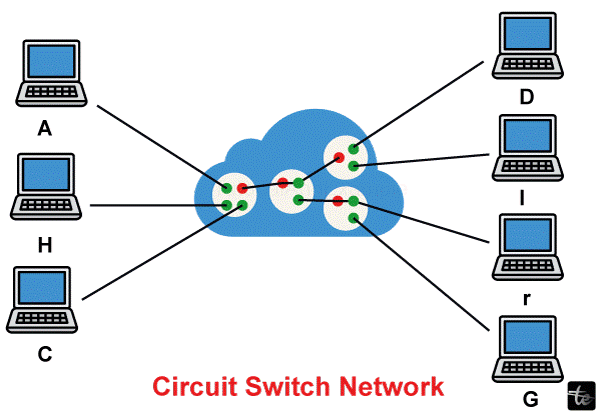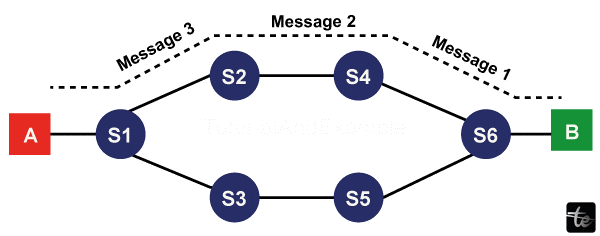Circuit Switching in Computer Networks
Introduction
In Computer Networks, circuit switching is a form of network setup which involves obtaining a physical path assigned to a single connection between two network endpoints for the duration of that connection. For example, regular telephone service makes use of circuit switching.
The length of a call is spent using this reserved circuit. The circuit cannot be utilized for other purposes while the call progresses.

The bandwidth and data transfer rate are fixed in circuit switching. Because circuit switching is connection-oriented, it requires a physical link to function across hosts.
Phases of Circuit Switching
The three stages of circuit switching are as follows:
- Circuit Establishment: A dedicated circuit is constructed between the two end devices or from the source to the destination using the number of intermediate switching centre offices. To request and acknowledge the construction of a circuit, communication signals are transmitted by the sender on the source and the receiver on the destination side. The physical links connect the intermediary switches.
- Data Transfer: Establishing a specific connection between the source and the destination. Voice and data are transported from one place to another. This link endures till the conclusion of the conversation.
- Disconnect the circuit: The circuit cuts the connection after the finished data transfer.
Characteristics of Circuit Switched Network
- Another name for it is the public network.
- Because the signals are voice signals, managing digital data and traffic is simple.
- It is feasible for the voice signal to be sent concurrently with an electric current.
- The method is referred to as connection-oriented.
- In a circuit switching network, the path must be established before transmitting data.
- The path can only be terminated when the connection is terminated. • The quantity of data transferred during circuit switching is fixed.
Types of Switches in Circuit Switching

In circuit switching, two sorts of switches are utilized, and they are as follows:
Space Division Switches
Space division switching involves separating the circuit's pathways from one another. The analogue network was the primary goal of the space division. But it's employed in both digital and analogue switching. Space division switches employ a switch type called a crosspoint switch. It uses semiconductor gates and finds usage in digital communication.
A space-division switch has the benefit of fast switching, but it also has the drawback of requiring blocking to determine the number of crosspoints.
Time-Division Switches
All connections in the time-division switching method use the same trunk line. Time-division multiplexing splits the streams into smaller pieces and ensures that the segments are supplied at predetermined times. A de-multiplexer is used to assist in the element detection process.
Uses of Circuit Switching
The following are some instances where circuit switching is mainly used:
- Continuous Connections: Circuit switching is employed for connections that must remain active for extended periods, such as long-distance communication. Circuit switching is a technology used in traditional telephone systems or landlines.
- Dial-up Network Connections: Computers that use dial-up services to access the internet do so over the public switching network. Internet Protocol (IP) data packets are transmitted via dial-up across a circuit-switched telephone network.
- Optical Circuit Switching: Circuit switching is also used in data centre networks. Traditional data centers can be scaled with optical circuit switching to accommodate expanding bandwidth needs.
Difference between Packet-Switched and Circuit-Switched Networks
Circuit-switched networks are connection-oriented, whereas packet-switched networks are connectionless. This is the primary distinction between the two types of networks. Packet switching is used in the telephone protocol known as voice-over IP.
Information is divided into data packets for packet switching, and each packet is sent over the network separately from the others. Unlike circuit switching, there is no fixed, dedicated channel. Rather, packets are transmitted via a shared network with other hosts. Additionally, transmission is not constant.
Switched virtual circuits are seen in certain packet-switched networks, such as X.25. Using packet-switching technology, virtual circuit switching creates a dedicated connection. A logical connection that is dedicated to allowing numerous virtual circuit connections to share a physical channel is called a virtual circuit-switched connection.
Packet switching does not pre-save all of a connection's bandwidth. It is, therefore, more energy-efficient. Packet switching has the potential to produce poor transmission quality due to missing or lost packets.
Examples of Circuit Switched Networks
Some instances of circuit-switched networks are as follows:
- ISDN B-channel
- Public Switched Telephone Network (PSTN)
- Optical Mesh Network
- High-speed Circuit-Switched Data (HSCSD) and Circuit-Switched Data (CSD) services in cellular networks such as GSM
Applications of Circuit Switching
- Traditional Telephone Networks: Early telephone networks were built on circuit switching. A dedicated circuit is created between you and the person you call when you dial a phone number, ensuring consistent speech quality throughout the discussion.
- Satellite Communications: In various satellite communication systems, especially those needing dependable and constant connections, circuit switching can link ground stations and satellites.
- Video Conferencing: Circuit switching can be utilized in some high-quality configurations that require dedicated resources to ensure uninterrupted video and audio streams, even though packet switching is more frequently used in modern video conferencing.
- ATM and Banking Networks: Circuit switching may be used by some ATM (Automated Teller Machine) networks and banking systems to provide dependable and secure communication for financial transactions.
- Military Communications: Circuit switching can establish dedicated, encrypted communication lines in a crisis, guaranteeing confidentiality and dependability.
Advantages of Circuit Switching
Circuit switching offers the following benefits:
- The primary benefit of circuit switching is establishing a dedicated transmission channel between the computers, which ensures a certain data rate.
- When using in-circuit switching, the dedicated transmission line ensures that data flow proceeds without delay.
- Reliability: Because the dedicated communication line is set aside for the duration of the connection, circuit switching offers a high degree of reliability. This guarantees that there won't be any data loss or corruption during transmission.
- Quality of service: Circuit switching ensures a particular level of service quality, allowing the network to prioritize some types of traffic over others, including voice and video, web browsing, and email, for example.
- Security: Because only the two communicating parties may access the dedicated communication line, circuit switching offers higher security than packet switching. By doing this, data breaches and illegal access may be avoided.
- Ease of management: Because the communication path for circuit switching is pre-established and allocated to a particular communication, it is comparatively simple to administer. Error risk can be decreased, and network administration can be made simpler as a result.
- Compatibility: Circuit switching may be utilized with various networks and applications because it is compatible with various devices and protocols. This renders the technology adaptable to several industries and scenarios.
Disadvantages of Circuit Switching
The following are some of Circuit switching drawbacks:
- The process of connection takes time.
- Dedicated channel setup requires more bandwidth.
- Because the connection is intended for circuit switching, it cannot send any other data, even if the channel is available.
- Limited Flexibility: Because circuit switching necessitates a dedicated circuit between the communication devices, it is not very adaptable. The network's flexibility is limited because the circuit cannot be used Waste of Resources for any other purpose until the transmission is finished.
- Resource Waste: Even if no data is transferred, circuit switching reserves network resources and bandwidth for the duration of the communication. As a result, resources are wasted, and the network is not used effectively.
- Expensive: Because circuit switching necessitates dedicated communication routes, which can be expensive to set up and maintain, it is an expensive technology. Because of this, small-scale networks and applications find it less practicable.
- Susceptible to Failure: Circuit switching depends on a specific communication line, so it is prone to failure. The entire conversation is interrupted if the path fails. Compared to other networking technologies like packet switching, this renders it less dependable.
- Not appropriate for bursty traffic: Circuit switching, which is the irregular data transmission at random intervals, is inappropriate for bursty traffic. This is because each communication has its circuit, which can create delays and wasteful resource usage.
Conclusion
In conclusion, landlines and conventional communications networks are based on circuit switching. The current internet is built on packet switching. Everyone has benefits and drawbacks. Additionally, there are instances where they overlap, such as when a packet-switching network creates a connection-oriented data transfer protocol by imitating circuit-switching technology.
Packet switching is used by most phone services and the internet today. However, circuit-switched traffic was intended for the majority of legacy networks. This disparity may be closed with the use of new optical routing architecture.